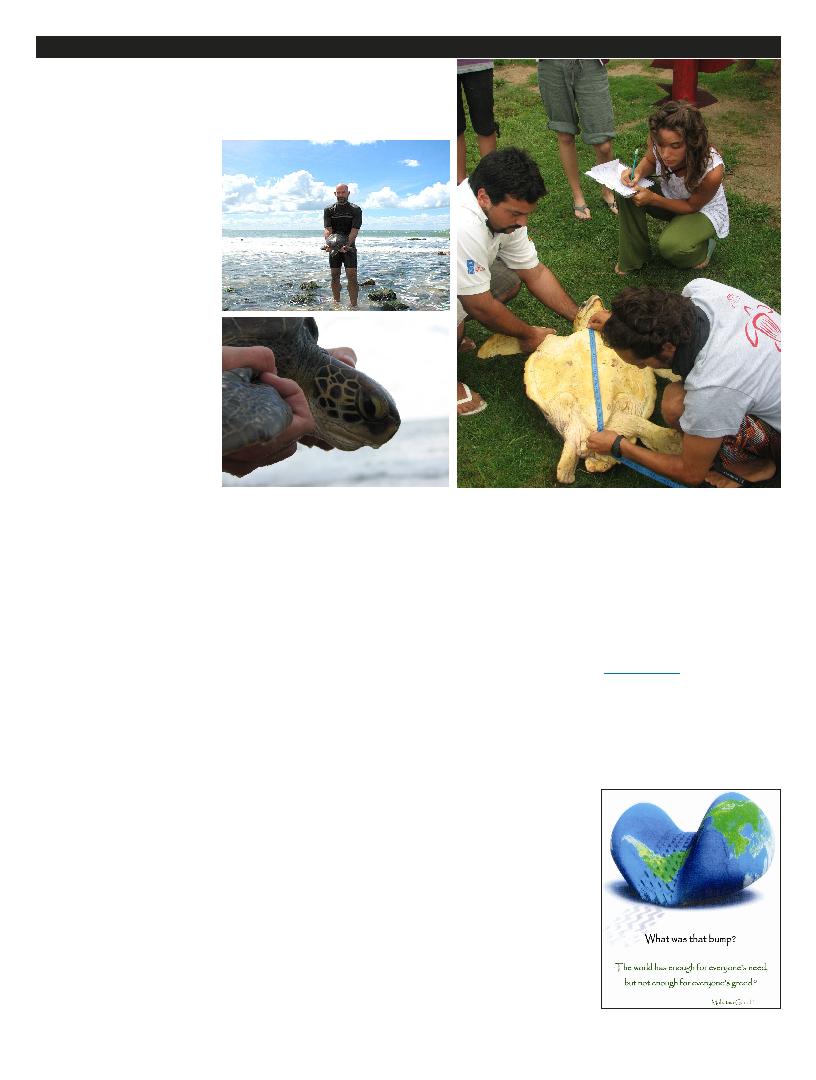
way up the coast of Uruguay to a
small town called La Coronilla,
about 22 km south of the Brazil-
unteer with a Marine Conservation
Group, which focuses on sea turtle re-
search, rehabilitation, education (of peo-
ple, not of turtles), and protection.
ence I had volunteering with jaguars in
Bolivia. There are great staff and volun-
teers. The work is immediately rewarding
and feels important. The hours vary and
the work can be easy or difficult depend-
ing on the weather and the animals. You
eat a lot of potatoes. The animals are en-
dangered and still being harmed need-
lessly. Any success in protecting these
animals is greatly beneficial to the major-
ity of other, less charismatic animals. I
suppose that the biggest difference here is
that when sea turtles get irritated and try
to bite, you don't poop yourself.
simply begin with a day in my life, as they
say. I chose a day while it was fresh in my
memory. Let's call it March 10, give or
take a couple days.
ing the sun rise over the water. The day
started with dolphins surfing and jumping
just offshore. It was a wonderfully com-
mon sight.
water, and sampling gear. There were four
volunteers and two researchers in our
group that day.
hike south along the beach from camp.
Already the weather was quite hot so we
made a sun shelter while preparing our
tangle net on the beach and donning our
wetsuits.
one end of the 50 metre net out past the
surf to a buoy anchored in 3.5 metres of
water (This activity is not specifically
mentioned in any risk management train-
ing I may have taken back in Canada).
The net was set perpendicular to the
shoreline and over a lot of rocks, where
Green turtles feed upon algae. It was a
very low tide, chosen so that we could
"fish" when so much algae is closer to the
surface. This is safer for both us and the
turtles.
Keeping its mouth out of the water, but
angled downward to allow any water in its
lungs to drain out, I swam it to shore. Af-
ter putting it in a box in the shade I pre-
pared some yerba mate to drink while we
pronounced "matay" is a hot, bitter drink
consumed in Uruguay in much the same
way as we consume tea and coffee in
North America.)
standards. Recorded measurements and
any scars; took DNA samples and a photo
of each one. We then applied metal tags in
the turtles' right flipper and recorded the
tag number, before having lunch. The tags
are unique to Karumbe and to Uruguay,
but similar to tags applied in Brazil and
South Africa. If they survive, "our" Green
turtles will migrate many thousands of
kilometres up the coast to North Brazil, or
even across the Atlantic at some point in
their lives, and lay eggs on those far away
beaches, which are hot enough to incubate
young turtles, unlike those in Uruguay.
like 40 inside our wetsuits. We recorded
weather, wave, and water data, enjoyed a
quick swim to cool off, and then carefully
released four of the turtles. We packed up
all our gear and then hiked back to camp
with Turtle Number Five. Turtle Number
Five would live in our visitor's centre for a
few days where visitors can get a close
look before the turtle is tagged and re-
leased back into the sea during a local
celebration. This is not done for the bene-
fit of this particular turtle, but to help cre-
ate understanding, respect, and excitement
within the community.
washed the wetsuits, and then I helped to
tube feed one of the very sick turtles. This
turtle had a blockage of plastic inside its
stomach and intestines. All Sea turtles
confuse bits of our plastic garbage for
food, and several hundred die each year in
Uruguay alone, plugged up with plastic. I
gave it an algae smoothie with vitamins,
antibiotics, and a laxative hoping that it
will poop out the blockage. Our success
rate is close to 50 per cent. Next, I wiped
the orange turtle vomit off my shorts,
showered, and hit the hammock for 30
minutes. Attempted to read. Failed.
Napped for 25 minutes.
an insult), a local fisherman who volun-
teered to cook for us, had prepared a salad
and amazing homemade cannelloni. Then
seconds of cannelloni. Undid belt a little
bit... then thirds. Discussed plans for to-
morrow, which always change as weather
is greatly unpredictable. Cleaned up.
and listened to some stories and music
while playing cards. Then off to bed by 11
or 12.
several reasons: it adds a bit of meaning
to my travels, it allows me to integrate
more with locals, I can learn a new lan-
guage without paying for classes, I can
in beautiful, safe locations without a lot of
other foreigners. It's a bit ironic, because
foreigners like myself, help to raise the
profile of local issues to the host govern-
ment.
Roy Argue worked with the Salmon En-
hancement Program and has enjoyed
travelling for many years, especially
throughout Latin America where he has
spent months volunteering.